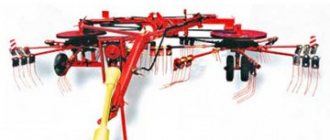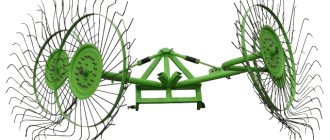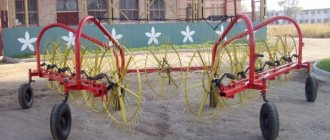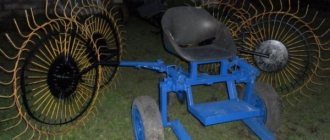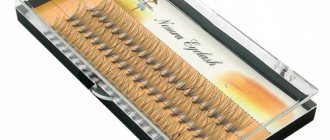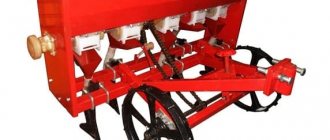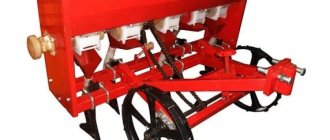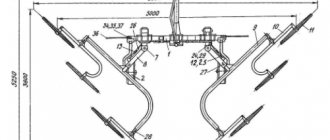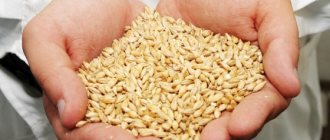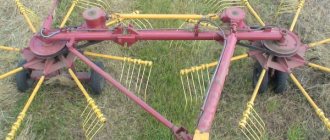Among the many trailed agricultural implements and mounted tools, tractor rakes deserve special attention.
The device optimizes work when tedding the mowing of low-stemmed plants and collecting hay. Using a walk-behind tractor or tractor, the equipment allows you to:
- collect dried grass in piles;
- stir up the mown, ensuring uniform drying of the hay;
- wrapping and scattering windrows of hay;
- double adjacent swaths of dried grass;
- clean the area after harvesting.
This type of work can be done by hand or with the help of a horse. However, the use of physically expensive manual labor can only be justified in small areas (summer cottage, garden). In other cases, it is advisable to use mounted tedder rakes on the tractor. They will help you quickly and efficiently complete your tasks.
Description of the tool
Windrowing is one of the main stages of hay harvesting.
Therefore, the demand for tedder rakes that effectively carry out this operation is constantly growing. To date, several types and modifications of similar equipment for tractors have been developed. The most popular types are rotary and wheeled mounted models. Tractor rotary tedders are a wheel-finger structure, the basis of which is thickened rotor pipes. The hay raking fingers are attached to these horizontally rotating rotors using springs with several teeth. This ensures uniform load on the device and good reproduction of the topography of the treated area.
Torque is transmitted to the rotors through cardan-type joints like car joints, which ensures equality of angular velocities. The drive is smooth and has protection against spontaneous starting during transportation. This type of tractor tedders has the ability to adjust the tedding height and angle of attack. They do not have their own power and are mounted on a wheeled tractor, working through a hydraulic system and a power take-off shaft.
Wheel rakes are a tractor-mounted structure made of floating wheels mounted on a console. They are equipped with bent wire fingers-springs for turning hay. Since outwardly such a device resembles a sun drawn by a child’s hand, this is the popular name these tractor tedders received.
The efficiency of their operation is increased due to the fact that the wheels are located at an angle relative to the direction of movement of the tractor and somewhat overlap each other’s rotation zones. The floating suspension provides excellent shock absorption, so the tedder copes well with uneven terrain, easily overcoming irrigation canals and embankments. Its wheels are interchangeable and each of them is mounted on two bearings, which increases the service life of the device and facilitates repairs. The wheels rotate independently and are carried out through a cardan, chain or belt drive. Therefore, such tedder rakes can be used as attachments for a tractor, mini tractor or walk-behind tractor.
Depending on the tractor model, devices with four and five wheels are available. The only difference between them is the working width, which determines the speed and productivity of tedding and raking the mown vegetation into windrows on a field of the same size. Also, such rake tedders are often made by hand. As a rule, these homemade devices are designed to be mounted on a small tractor or walk-behind tractor used on the farm.
Homemade equipment
To make homemade equipment for a walk-behind tractor at home, which helps you quickly and efficiently remove hay, the following spare parts are used:
- 2 wheels with a diameter from 30 to 50 cm (you can take car wheels);
- a rod or pipe for metal (the axle is made from it);
- drawbar (made from a profile pipe);
- rods with a diameter of about 6-8 mm (used for teeth);
- springs;
- pipes with a diameter of 3 cm for the axle and 4 cm for fastening.
The entire homemade mechanism consists of:
- drawbar;
- lever;
- a rod that raises and lowers the rake;
- strut;
- racks;
- fork or rake with teeth;
- hubs;
- axles;
- wheels
The following tools should be used:
- hacksaw;
- hammer;
- welding machine;
- hammer drill
Gardeners recommend choosing a folding rake model. They are more convenient and mobile during transportation. It is from a homemade rake that you can achieve speed and mobility in harvesting hay.
Important! All work must be carried out only in accordance with the drawing. You can compose it yourself. During manufacturing, pipe sections are welded into one piece
If the size allows, then they can be inserted very firmly (one pipe into another). The traction mechanism is the rotation of the walk-behind tractor. In this case, there is no need to insert bearings into the wheels. You can choose any rake grip diameter
During manufacturing, pipe sections are welded into one piece. If the size allows, then they can be inserted very firmly (one pipe into another). The traction mechanism is the rotation of the walk-behind tractor. In this case, there is no need to insert bearings into the wheels. You can choose any rake grip diameter.
The first step is to build a base. To do this, wheels are put on the axle. Pads are welded onto the axle to strengthen the fastening of the mechanism. Strips of solid steel are suitable as platforms; they are fixed at a distance of approximately 12 cm from the wheel.
Important! The drawbar is fixed exactly in the center of the wheel axis. The working mechanism is made as follows. Stands are welded onto the wheel axle, to which 2 pieces of pipe with a diameter of 4 cm are also welded.
The rake axis is inserted into it, which should turn freely. Locking rings are made on both sides to prevent the rake from moving to the sides. After performing these operations, the rake is equipped with a lever necessary to change the vertical position of the teeth
Stands are welded onto the wheel axle, to which two pieces of pipe with a diameter of 4 cm are also welded. The rake axle is inserted into it, which should turn freely. Locking rings are made on both sides to prevent the rake from moving to the sides. After performing these operations, the rake is equipped with a lever necessary to change the vertical position of the teeth
The working mechanism is made as follows. Stands are welded onto the wheel axle, to which two pieces of pipe with a diameter of 4 cm are also welded. The rake axle is inserted into it, which should turn freely. Locking rings are made on both sides to prevent the rake from moving to the sides. After performing these operations, the rake is equipped with a lever necessary to change the vertical position of the teeth.
Homemade rake for walk-behind tractor
The teeth are attached to the rake axle. It is recommended to make them from wire with a diameter of at least 6 mm. They are best secured by welding. The stand along with the seat is attached to the drawbar.
Important! It is better to provide the lever with an additional spring so as not to waste effort holding it with your hands. After testing a homemade attachment on a walk-behind tractor, it will be clear whether it is worth correcting possible defects in it. To make it last longer, you should lubricate all parts subject to strong friction with grease.
To make it last longer, you should lubricate all parts subject to strong friction with grease.
After testing a homemade attachment on a walk-behind tractor, it will be clear whether it is worth correcting possible defects in it. To make it last longer, you should lubricate all parts subject to strong friction with grease.
A rake for a walk-behind tractor is a device that greatly facilitates any agricultural work. Models existing on the market are suitable for almost all types of walk-behind tractors. An amateur gardener can easily make a high-quality model of a rake for a walk-behind tractor with his own hands, having simple available tools.
What are the advantages
Both rotary and wheeled tractor tedder rakes rake the crop into windrows, making it easier for the baler to bale later. With their help, layers of hay are turned over, exposing the desired side of the windrow to drying under the sun's rays and wind blowing, thereby speeding up the process of drying the hay. Tractor rotary models have good speed and are the optimal tool for working with crops that require careful handling (for example, alfalfa). Also, a tractor with this type of tedder can easily handle wet or heavy hay.
Wheeled tractor tedder rakes are characterized by the highest productivity and work well at high speeds. Their effectiveness is maximum over a long straight distance, but deteriorates in corner areas of the cultivated area. They are easily mounted on the tractor, without requiring the connection of a power take-off shaft for operation.
The fingers on the wheels of such a tedder not only turn over the mown vegetation, but fluff it up, thereby increasing ventilation in the hay windrows. A tractor with a similar attachment processes the field with minimal loss of mown leaves when harvesting hay for forage crops. In addition, such a sun-type design for a small tractor or walk-behind tractor can be made with your own hands.
Technical capabilities of the device
Do-it-yourself attachment to a mini tractor
The most important advantage of the unit is that its maintenance and operation are carried out by one operator. Other features include the absence of complex parts and the independent installation of component parts of the equipment, so repairs in the event of unexpected breakdowns can be carried out directly in the field. Another advantage of tedder rakes is the ability to connect windrows, tedding, shaking and airing them, which contributes to high-quality pressing into bales. The capabilities of rotary rakes allow them to carefully handle crops, as well as successfully collect wet hay.
Note! The operation of wheeled tedders is characterized by high productivity and good speed. They work especially well on straight, level areas. Such machines are good for use when harvesting hay from forage crops.
Another design that resembles the sun, a do-it-yourself tedder rake, can be made for small-sized equipment (mini tractor or MTZ walk-behind tractor).
How to do it yourself
For a small tractor or walk-behind tractor, mounted rakes and tedders are not so difficult to make yourself with certain skills. On the Internet you can freely download detailed drawings that allow you to choose a frame option with two or one section and the optimal number of wheels for implementation. For those who want to make such a device with their own hands, enthusiasts have posted a large number of videos on the Internet, which show step by step how the authors created their tractor rake and tedder.
For a walk-behind tractor, homemade sun-type tedders have no more than three wheels, and those intended for hanging on a small tractor may well have five wheels. To create a tedder with your own hands, you will need a metal pipe to make a welded frame on which brackets for attaching the wheels are installed. You will also need 4 - 7 mm steel wire to make springs raking the mown grass. They are replaceable and are attached to the discs with bolts. The impeller disks are made of steel sheets 4 mm thick.
Each wheel is mounted using two bearings located in the hubs. You can install hubs from a classic VAZ car model with tapered bearings. Such a unit will be sealed thanks to a metal cap on one side and an oil seal on the other. Such tractor rakes can be stored outside without fear that the bearings will rust.
You will also need to make a special attachment to hang such homemade devices on a tractor or walk-behind tractor. Its design is created in accordance with the selected drawings and includes an adjustment mechanism using powerful steel springs. When harvesting hay, such homemade mounted tractor rakes and tedders are practically in no way inferior to industrial models, and sometimes even surpass them in build quality and careful manufacturing of parts.
DIY mounted and rotary tedders
Now let's get acquainted with the process of assembling and installing the tedder with our own hands. We will consider two design options: rotary and “Sun” type.
Rotary tedder
At the very beginning, you need to make a frame from metal tubes, the dimensions of which are directly related to the power and traction of your walk-behind tractor or tractor.
Using a round or square pipe will be equally effective. However, it will be a little easier to work with the latter, since you will be able to better fit the parts together, adjusting them exactly to the size. In this case, the design feature is to make one of the sides of the frame the same size with the hinge, and make the other in the form of an element tapering towards the end. Using the cardan shaft, the rotor itself, which is necessary for the operation of the tedder, will be driven. An alternative to a driveshaft can be a used rear axle from a passenger car.
If you are making a turner that will be attached to a tractor, you should equip the power take-off shaft with a special reduction gearbox. This need is due to the fact that most tractors produce about 540 revolutions per minute, which is too high a speed for a homemade turner.
A metal car disk will be used as the rotor itself, to the body of which 10 tubes of equal length and thickness must be welded in such a way as to end up with a kind of “sun”, that is, the tubes should extend slightly beyond the disk.
Once the tubes have taken their place on the pre-marked car rim, you can begin attaching the teeth for your mechanical rake. Such teeth can be made from thick metal wire and durable steel rod. Armed with a welding machine, attach all the teeth to the rotor. That's all. The rotary tedder is ready for testing and further use.
Classic turner type “Sun”
This type of tedder assumes a three-wheel design for walk-behind tractors and a five-wheel design for tractors, due to their different traction forces.
To create it you will need:
- metal tubes of square or round cross-section;
- thick steel wire;
- several metal sheets about 4 mm thick.
Scheme of constructing a tedder rake Using a grinder and a welding machine, steel tubes are cut and fastened together, which form the main frame of the device. Brackets for wheels are attached to the tube frame. The disks of future turners themselves are made of sheets of durable steel (as an option, you can use frames from bicycle wheels, but they need to be additionally reinforced with metal rods and linings so that they do not fall apart during operation).
Using thick steel wire, make fingers (hooks) that will become a kind of intake for mowed grass, straw or fallen leaves. It is better to make such hooks replaceable - to do this, use clamping mechanisms or bolted fastenings that can be disassembled and replaced if necessary.
For successful installation of such needle wheels, it is necessary to use bearings that are inserted into the hubs.
The next stage of assembling the tedder with your own hands will be the installation of a hitch, with the help of which docking with the vehicle will be made. Such a hitch must be additionally equipped with steel springs for shock absorption and special elements of a lifting mechanism, which will lift the rake off the ground in the necessary places and return them to their place when the machine takes the desired position and can continue working.
Progress in technology and modernization of tools have become indispensable attributes of our daily lives. Now you have learned how to assemble mounted turners at home with your own hands. Now you can make your work much easier when it comes to raking fallen leaves or mown hay, you won’t have to manually turn the hay on all sides. A turner can perform this long and labor-intensive operation for you.
Read also: Growing marjoram with seeds in open ground, video
VIDEO: INSTRUCTIONS FOR CREATING 4-WHEEL MOUNTED Tedder RAKES
Tedder rake: varieties and application in agriculture
Harvesting hay has always been considered a promising area of agricultural activity. After all, this is the most practical way to provide feed for livestock during the winter.
At the dawn of technological progress, this event was carried out in two stages: men mowed the grass, which was then raked into windrows. This hay harvesting scheme looks quite expensive. Currently, tedder rakes are used to rake hay.
It is worth noting that this equipment has nothing in common with ordinary rakes, which are available in every subsidiary farm. In fact, this is a multi-purpose complex that operates automatically and forms hay into neat windrows, convenient for transportation and storage.
Please note that the equipment is operated by one operator. In this article, we will look at the technical parameters of such units and tell you how you can make a tedder rake yourself.
Types of nozzles
Various attachments can be useful on the farm. Therefore, the more of them the walk-behind tractor has, the better. There are belt rakes, cross rakes, or with turners; the choice depends on the purpose for which the walk-behind tractor will be used (for example, for collecting hay, leaves or garbage) and the model of the equipment. Some types can even be used for collecting snow and cleaning paths.
A huge variety of models are offered by specialized stores. Here you can find any attachments for a walk-behind tractor at very affordable prices. Making a rake yourself will cost much less.
The nozzle is adjustable in width. Its working part is almost 1.5 m. This makes cleaning the area as fast and efficient as possible. At the same time, such a width allows you to conveniently work both in large spaces and in small areas.
A special feature of the rakes for the Neva walk-behind tractor is that they are made on a spring basis. As a result of this approach, they are not in one position, but slightly change their amplitude during movement. This allows you to better collect garbage, hay, leaves, etc. Moreover, such attachments are not afraid of stones, so their teeth will not break off. They can be lowered and raised using a special lever.
Important! Some models of attachments are great for clearing snow and clearing yard paths. In specialized stores you can find a huge selection of attachments for walk-behind tractors. The product range is selected taking into account the requirements of the most demanding customers
The product range is selected taking into account the requirements of the most demanding customers
In specialized stores you can find a huge selection of attachments for walk-behind tractors. The product range is selected taking into account the requirements of the most demanding customers.
A special feature of this walk-behind tractor is the presence of a special adapter for different types of attachments. It is suitable for any type of equipment, because the adapter adapts to any size of attachments. The width of the working part of the rake is about 1.5 m. This allows you to perform high-quality agricultural work in areas of different sizes.
The design of the rake has a spring base. Thanks to this, they easily walk along the ground and change amplitude. The rake is quite flexible and works without breaking. The user does not need to change the teeth frequently. The nozzle is lowered and raised using an easily integrated manual mechanism.
Motoblock Neva
Thanks to the well-chosen design of the tedder rake for the Neva walk-behind tractor, you can effectively turn hay and remove straw and leaves. The attachment turns this walk-behind tractor into a productive piece of equipment for solving many important tasks.
With this rake you can:
- cultivate and prepare the soil in small areas (0.2-0.3 ha);
- harvest crops and harvest grass;
- effectively clean garden plots.
Design Features
The mounted tedder rake is a wheel-finger type unit mounted on an all-metal frame. The design is based on rotating rotors, each of which is placed in a separate unit.
The rotors are mounted on tapered bearings; the power required for rotation is transmitted through the driveshaft of the tractor. Each rotor is equipped with raking fingers made of high-strength steel.
There are about forty fingers per rotor. To prevent working elements from receiving mechanical damage, the fingers are attached to a spring suspension.
Tedder rakes are classified in several ways:
- According to the type of tractor used. There are two categories here: tractor and horse-drawn. The first group performs the function of mounted or semi-mounted equipment for tractors, the second is intended for walk-behind tractors.
- According to the method of windrow formation. Here we can distinguish transverse and lateral units.
- According to the design of working elements. There are three types of tedder rakes on sale. Wheel-finger: they have a shock absorption system for working elements, so they are optimally suited for fields with complex terrain. Drum: durable and reliable design consisting of independently rotating rings. Toothed: units with variable angles of rotation and inclination of teeth.
- According to the type of attachment to the vehicle.
Due to the design of the working elements, these units are called “sun rake”. This equipment is available in several modifications. The key differences between the models are the number of installed rotors: 4 or 5.
The area covered and, accordingly, the performance of the equipment directly depend on this. The average productivity of tedders is 6-8 hectares per hour. The recommended moisture content of hay should not exceed 70%.
An exception is the GVK-6 model, which is capable of forming windrows of plant material with a moisture content of 85%.
The tedder rake is operated and maintained by one tractor driver. Due to the absence of complex elements and the independent installation of rotors, replacement of damaged working elements can be carried out in the field.
The advantages of tedder rakes include the ability to adjust and double the rolls. In addition, the equipment can shake up ready-made windrows, which eliminates the risk of grass maturing. Among the shortcomings, a weak chassis can be noted. This problem is especially noticeable in trailed models.
Operating principle and design features
In order for mounted rakes to work properly, it is necessary to select equipment based on the traction class of the tractor. The most popular models are designed to work with mini-tractors; therefore, they do not have a wide coverage and are suitable for use in small areas.
With heavy tractors it is advantageous to use wide-cut equipment. If you do not take these nuances into account, you will not be able to achieve maximum efficiency of the unit.
Wheel-finger rake GKP-6.1
Mounted rakes can consist of one or several sections. Almost all models have their own wheels and, accordingly, belong to the category of semi-mounted equipment.
It is worth noting that usually the drive goes to only one wheel. The position of the frame is changed by adjusting the drive wheel. Sections with steel teeth are attached to the frame.
They are the working part of the equipment.
The teeth are made of high-strength material, so they do not suffer mechanical damage even when colliding with stones or debris.
Depending on the design, hay rakes can be divided into three groups:
- Rotary. Perhaps these are the most expensive models on the agricultural equipment market. Rotary rakes are quite functional: they can not only turn up the grass, but also form windrows. It is worth noting that almost all models can operate in automatic mode.
- Wheel-finger. This equipment can only be used for dry beveling. This is the only drawback of the product. Thanks to a well-thought-out design, wheel-finger units show good performance and are rightfully considered the most practical products.
- Transverse. The simplest units in terms of their technical characteristics. Such rakes do not stir up the bevel, but only rake it into windrows. The performance of the equipment directly depends on the width of the area covered and the power of the tractor. The one-sidedness of the work is compensated by the low cost of the equipment.
Can I do it myself?
We have already mentioned that the tedder rake does not have technically complex components and elements in its design, so if you wish, you can make such a unit with your own hands.
On the Internet you can find various diagrams and drawings of tedders designed and developed by home craftsmen. Considering that not every farmer has a tractor, we will present a basic design that is quite suitable for working with a walk-behind tractor.
Please note that a three-wheeled tedder rake is sufficient for a walk-behind tractor. If the equipment will be used with a tractor, the number of rotors can be increased to 5.
As a basis for homemade tedder rakes, a metal pipe is used, on which brackets for attaching the rotors are installed.
To ensure free rotation of the working elements, you will need two tapered bearings and a hub (for each rotor). This element can be borrowed ready-made from a VAZ car.
Advantages
The simplicity and strength of the tedder design make it possible to use this type of hay harvesting equipment on almost any soil. The rake teeth and most parts of the unit are made of durable spring steel, thanks to which the rake can work even after being hit by stones. Even self-made mounted tedder rakes on a tractor allow you to efficiently and carefully collect the mown dry plant mass and place it in even hay windrows. The most popular are the “Solnyshko” tedders. This is due to a number of advantages:
- minimal equipment maintenance costs;
- the hinged design ensures a long service life;
- the design has a powerful frame and traction drawbar;
- convenient transfer of equipment to transport or working condition;
- price.
Design Features
All tractor machines and walk-behind tractors accept tedders with 4 and 5 wheels. Such rakes work well with low-power tractor devices (up to 25 horsepower), agricultural walk-behind tractors and walk-behind tractor adapters. The rake is presented in the form of wheels with curved rods. The two most popular types are:
- Rotary . The design, called “finger”, is fixed on the rotating motor sections. Special beams are attached to them by installing springs that are directly involved in assembling and turning grass and hay. This allows you to easily control and change both the height and angle of tedding.
- Wheeled . Convenient to use: the wheels (their number can be from 3 to 5) are located obliquely from each other. This significantly increases the productivity of work and the speed of its implementation. The wheels can replace each other, each of them is mounted on two bearings: this greatly simplifies the repair process in the event of a breakdown.
Regardless of the choice made, the quality of harvesting, tedding, and the speed of the work performed will be many times higher than the quality and speed of manual execution.
Homemade cross rake
Hello! I'm going to assemble a 3-meter transverse rake for harvesting hay. Who has a photo? Has anyone made the teeth themselves? How much are Zovod teeth? Otherwise they ask us for 240 rubles for one tooth. Thank you!
Hello! I'm going to assemble a 3-meter transverse rake for harvesting hay. Who has a photo? Has anyone made the teeth themselves? How much are Zovod teeth? Otherwise they ask us for 240 rubles for one tooth. Thank you!
Catch! The base pipe to it is a standard section and the wheel from Tavria is cut off from the rear beam. Files: imgp0880_0.jpg imgp0878.jpg
Thanks Alexey I. How many teeth? where can I buy these teeth cheap or make my own? Where's the hydraulics?
Thanks Alexey I. How many teeth? where can I buy these teeth cheap or make my own? Where's the hydraulics?
This is a rake of a friend, mine has hydraulics, there is a photo but not very good. Homemade fingers are a hassle to make! Rake fingers in our store were 120 rubles each. Make a request and they will deliver it cheaper. Ask someone if they have it. I found towed vintage ones for 8 thousand rubles. in the photo below, two of them can be made. Files: imgp0391.jpg
Hello Alexey. where are they sold? could you send me your contact information?
Hello Alexey. where are they sold? could you send me your contact information?
We have a store in our village, I’ll find out where they get it from! It’s 200 km from us to Birsk. I can try to send you with someone along the way, if necessary. But first I’ll clarify. Write in a personal message.
Changed by the Editor : There is a forum for advertising “” the rules for posting in this forum are written here .
You can also place your commercial offer completely free of charge in the “ offers ”
Alexey And I’m a beginner haymaker, I had about the same rake for a year and then I made a rake like the factory ones, the raking speed increased two and a half times. Teeth in Volgograd cost about the same
Alexey And I’m a beginner haymaker. I had about the same rake for a year and then made a rolled one similar to the factory ones. The raking speed increased two and a half times. Teeth in Volgograd cost about the same
Show a photo of the rake if possible.
My father and I made a folding transverse rakes in our yard; on the way, a 5-meter rakes are not an option, we looked at the option that is produced at the factory like a hinged one, it’s heavy and not reliable. We came up with our own way to fold it. Having looked on the Internet, no one has posted it yet, or it wasn’t possible, or whoever thought of it didn’t post it on the internet, or I didn’t search well. So I decided to tell everyone how to do it better. The design consists of two frames, one T-shaped on it and this rake itself is supported with a hydraulic cylinder. And the other consists of a chassis and a hitch, and the first frame rotates on it like on a swivel. in the transport position, the frame with the rake rotates and is secured along the hitch. Very comfortably. Files: 073_1.jpg 024_3.jpg 022_4.jpg 025_4.jpg
But no one has indicated how the teeth are attached to the beam.
Preparatory work
Any farmer can learn how to make a tractor rake with his own hands. If a person already has the skill to handle or create such equipment, making a hay tedder for a tractor yourself will not be difficult. In order to make a rotary tedder yourself, you need to make a metal frame from a round and angular pipe. The rotor, without which the tedder process becomes impossible, can be easily replaced with the rear axle of a regular car.
Before starting work, it is necessary to sketch out drawings that will gradually be implemented into the design. If you are making a hay rake for a tractor, it is important to install a reduction gearbox on the power take-off shaft. In many tractor machines, the number of shaft revolutions per minute is approximately 540. And this is already an impressive figure for turners. 10 tubes in the shape of a “sun” are welded to the machine disk. The rake teeth are made of strong steel and are attached to the rotor using a welding machine.
Drawings and assembly instructions
Assembling the device with your own hands is a doable task even without special knowledge.
Mounted wheeled
We are talking about “sun” type rakes, which are so called because of the tedder wheels located on both sides of the mini tractor. The advantages of the design are the speed of raking and turning hay, as well as a long service life. In total, 3-5 wheels are placed on the “sun”.
For assembly you will need:
- grinder, drill, wrenches, welding and other tools;
- metal pipe (you can use a motorcycle frame);
- thick wire to form the fingers of the instrument;
- brackets;
- sheets of metal, such as steel, to make discs;
- bearings: 2 per wheel;
- spare parts for the fastening device to attach the tedders to the tractor (for example, car hubs).
According to the drawing, you need to assemble the parts into one structure, then attach the “sun” to the tractor.
Tape design
This tool is suitable for collecting and tedding freshly cut grass and hay.
A distinctive feature of tedders is the extensive coverage of the treated area with a low weight of the implement.
Since there are no wheels in the design, the rake is considered to be mounted.
Rotary rake
Farmers use them to collect and form windrows of fragile types of hay. The “fingers” gently beat and turn the crops, maintaining the quality of the grass without loss of mass.
For assembly you will need:
- metal pipes with a diameter of about 5 cm and rods - 1 cm;
- metal for frame;
- chain and gears;
- metal sheet for strengthening;
- cardan shaft
Build process:
- Preparing the frame. Its width should be suitable for the mount, and its length should be suitable for the grip radius. For example, with a span of 3.5 m, the length of the frame will be 2.5 m. The shape that works best is a crane boom, i.e. at one end it is wide, and at the other it narrows.
- Preparing the rotor. It will be driven by a cardan shaft, which is used as the rear axles of cars (since they have the necessary gears).
- Attach pipes about 40 cm long to the rotor. To do this, you need to drill holes for them at equal distances in diameter.
- Make rake “fingers” from rods, secure them to the pipes with bolts or weld them.
- Attach the rotor to the frame. In order for the design to work correctly, you need to adjust the gears for raking and tedding. The shaft must be divided in half and the parts placed on opposite sides so that the rotation speed is reduced to 80 and 20 rpm, respectively.
- Attach one part to the frame using plates with bearings.
- The second one is to be attached to the bottom with springs. Place the gears on the shaft and connect them with a chain.
To change gears, the worker will need to change the gear and chain length.
Manufacturing process
Homemade tedders are easy to use, however, repairs may require the services of a specialist - especially if the rakes were made from low-quality materials.
The manufacture of mounted wheel tedders is carried out mainly for mini tractors and walk-behind tractors. A three-wheeled tedder is used for walk-behind tractors, and a five-wheeled one is used for tractors. To start making a tedder, you need to prepare the following tools:
- Metal pipe.
- Wire up to 0.7 cm thick.
- Steel layers 3-4 mm thick.
A frame is made from a pipe, and brackets are placed on it. Wheels are attached to them. Special bends are made from wire - “fingers”, designed for raking the mown grass. They are attached to the disks with special bolts. To install the wheels, two bearings installed in the hubs are useful. After this, the hitch is made, and only then the rake is installed on the tractor.
Properly made rakes and tedders will help make the process of collecting and tedding hay easier, as well as baling it. Rotary models are distinguished by their careful handling of crops that require careful assembly (such crops, for example, include alfalfa). Tractors with tedders easily cope with heavy work: turning over and collecting wet, heavy hay.
Required material and tools
First, you need to take care of the availability of tools, since all further work will depend on this. First of all, you need a welding machine, an angle grinder, an adjustable wrench and a drill with a metal drill. If there should be no problems with cutting metal, then quality welds will require skill. The rotor will rotate at fairly high speeds, and if it breaks, it can damage the tractor or create a dangerous situation for human life.
For the homemade rotary rake itself, you will need metal rods 10 mm wide for the tractor, tubes with an outer diameter of 50 mm and an inner diameter of 50 mm, you can also choose a metal profile for the frame. Next, you need a driveshaft, or rather, its articulated part, as well as a set of gears and a chain, which will be described later. For various works on strengthening the structure and the like, sheet steel 5 mm thick is required. For the rotor itself, the rear axle assembly of the car is best suited, and the presence of a native driveshaft will only be for the better.
Photo of homemade rotary rake for tractor T-25
Rakes and tedders for tractors: varieties, do-it-yourself production
Rakes have always been a necessary hand tool for homeowners. Virtually no land work could be done without their help. They could rake up garbage or mown grass, break clods of earth, and level beds. But their main purpose, then and now, concerns drying and harvesting hay.
With the introduction of technological progress in agriculture, even drying and harvesting hay has ceased to be hard manual labor. With the help of tractor-mounted hay rakes, these labor-intensive processes will no longer take so much time. Let's take a closer look at this type of attachment.
Description
All village residents and dacha owners have to clear the area of fallen leaves every year. This labor-intensive task requires several days, or even a week (depending on the size of the garden plot). An even bigger problem is the time of haymaking and the need for a long time to dry the hay under the sun with constant turning and ventilation, especially when we are talking about several hectares of hay harvesting surface. This work can be made easier by acquiring a special turner, which is attached to the mini tractor on hinged holders.
We recommend finding out which mini-tractors are the best: Japanese or Chinese. Also check out all the advantages and disadvantages of the Bulat-120, KMZ-012, Belarus-132n mini-tractors.
This device looks like a metal beam, to which several (two or more) needle wheels, similar to bicycle wheels, are attached on holders, only with curved hooks made of thick wire along the rim. The rotating mechanism is directly connected to the engine using a power take-off shaft.
Rakes and tedders for mini tractors In addition, tedders have their own classification, dividing them according to the different functions they perform.
Did you know? The oldest tool, shaped like a rake, was created during the Mesolithic period (about 15 thousand years BC). This is evidenced by finds at the sites of ancient people.
Types of rakes for tractors
Tractor rakes for hay have the same purpose as manual ones - turning over, raking grass, forming windrows of hay. They can be classified according to different parameters - by the type of working mechanism, by the method of fastening and traction, by the method of forming windrows, etc. But still, the main criterion by which tractor rakes differ is by design. There are 3 types of rakes:
Wheel mounted rakes for tractor
This includes the “Sun” type rake, popular among users, which is suitable for mini tractors and heavy implements.
The design allows you to quickly and efficiently turn and rake hay on both sides of the unit. The design provides from 3 to 5 or more tedder impellers.
Also, the advantages of this type of rake for a tractor include:
- ease of use and ease of repair, long service life;
- power and performance;
- The adjustment is hydraulic, the operator can easily and comfortably control the working position of the hitch.
Rotary windrow rake
They operate from the power take-off shaft.
The design is a horizontal disk with metal pipes onto which fingers made of steel rods are attached. Compared to the previous species, they have a slightly limited specialization - collecting hay and forming windrows. Although the hay also moves during the process, air circulation improves. Also, this type of tractor rake is more suitable for fragile types of hay that require careful care (for example, alfalfa).
Belt rake for tractor
More productive and technologically advanced units.
Designed for collecting and turning freshly cut grass and hay. Suitable for tractors with power from 20 HP. s., productivity – about 1.5 ha/hour.
Application of tedder rakes
After mowing, you should prepare the grass for turning it into hay. This means that it is necessary to form windrows, turn over from time to time, and collect into bales or rolls. Factory or homemade tedder rakes collect the mown grass into windrows and, if necessary, turn them over to dry. To use hay harvesting equipment, walk-behind tractors, mini tractors, tractors and even horses are used. This is much more efficient than working with hand tools. You can perform the following operations:
- raking of mown plant matter;
- tedding the grass;
- windrow wrapping and spreading;
- doubling of arranged rows of rolls.
Do-it-yourself rakes for mini tractors have a number of advantages. The device is more efficient than hand tools, is easily transported to the storage area and takes up little space. Affordable price and no problems purchasing spare parts.
All tedders can be divided into several types. For example, rakes differ in the rotation of the working elements when forming transverse and lateral rolls. They are also divided according to the type of working mechanisms:
- wheel-finger, allowing you to make rolls of the required size. This type can only work with dry plant mass and this is perhaps the only drawback. Thanks to the thoughtful design of the rake, tedders of this type are characterized by good performance and are considered the most practical;
- drum or rotary, characterized by structural strength and independent arrangement of raking wheels. They are considered the most expensive models on the agricultural equipment market, but this is justified by their functionality. This type of equipment can not only turn over the mown plant mass, but also form neat windrows from it;
- tooth tedders. Thanks to the design, it is possible to change the angles of inclination of the working elements.
Depending on the type of traction, the equipment can be either tractor or horse. The second type can be used together with a walk-behind tractor. Installation of factory or homemade rakes is possible in three ways:
- trailed (installed on tractors);
- semi-mounted rakes (the most affordable);
- mounted tedders (aggregated with walk-behind tractors and mini tractors).
Rotary tedders are considered the most expensive, so many people prefer to do it themselves, especially since there are no problems with spare parts. They can be purchased in specialized stores or removed from old equipment. Making your own rake is not that difficult; all you need is the desire and experience in handling a plumbing tool.
How to make a rake for a tractor?
Making a rake for a tractor with your own hands is not that difficult. A homemade design will differ from the factory one in parameters that are ideally selected for your conditions of use. Before starting production, you should decide on the type of future equipment (wheeled or rotary rakes). First of all, the choice will depend on the type of terrain. Rotary rakes are suitable for flat terrain, as they work at a certain height. On hilly, uneven surfaces it will be easier to work with a wheeled adjustable rake.
You should also acquire drawings, tools and necessary supplies.
The principle of operation of the design
Tedder rake
The operation of the equipment is based on the transmission of the rotational motion of the tractor or walk-behind tractor engine to the rake mechanism. This allows you to use up to five pairs of wheels and carry out hay harvesting over a large area. Using special devices on wheels that resemble large hooks, you can perform several types of work: prying up armfuls of grass or shocks of straw, turning over or raking.
Everything will depend on the setting of the angle of the needle wheels. This will allow you to combine or vary the functions of the machine. You can set the rake so that it collects grass in the center or, conversely, arranges it in a row to collect hay from the front. Thanks to the simple operating principle of the unit, it will be easy to work with. Therefore, it will not be difficult for a self-taught craftsman to make a homemade rake for harvesting hay for a tractor with his own hands.
Mounted tedder rake
How to make your own rake for a mini tractor?
A rake for a mini tractor is also not the least important type of attachment. According to the design they are divided into 2 types:
- wheeled trailed (rakes of the “Sun” type);
- rotary rake.
The choice of one or another type of rake-tedder for a mini tractor depends on your individual preferences and the nature of the work to be done. The mentioned types of rakes for mini tractors have a number of differences and features.
The “Solnyshko” rake for a mini tractor has the following features:
- large grip area and speed of operation (the design consists of an average of 3-5 wheels);
- small costs of time and money for repairs and maintenance;
- convenient adjustable design that allows you to work on uneven terrain;
Rotary rakes have the following features:
- in addition to stirring and turning the hay, they collect the hay into windrows;
- operate from the power take-off shaft;
- It is easier to work with a rotary rake in areas with flat terrain.
Homemade rotary rake for the T-25 or T-40 tractor: instructions, features, photos and videos
Raising livestock requires quite a lot of feed, such as hay and a variety of grasses.
However, to grow, mow and harvest them yourself, you will also need a variety of devices, which together can cost quite a pretty penny.
The solution may be to independently manufacture certain equipment, for which improvised materials and even what previously might have seemed like garbage are often suitable.
Although a homemade design may have a number of limitations caused by the manufacturer’s plumbing skills or available materials, it will help you save a lot. Also, based on your own needs, you can choose the width of the rake or set limiters to select the size of the windrow.
Depending on the topography of the field, it is worth considering two options, namely fully mounted equipment or a rotary rake with its own axis, which will allow the rake to always be at the same distance from the ground.
Features of a rake for a mini tractor
According to their design, rakes for mini tractors are usually classified into 2 types:
- rake-tedder for a mini-tractor of the “Solnyshko” type;
- rotary rake.
Each of the presented designs has its own characteristics and advantages. The choice of this trailed equipment also depends on the nature of the upcoming work and the topography of the hayfield. For example, the “Solnyshko” rake for a mini tractor is suitable for areas with uneven surfaces, since their height is easy to control during operation. Also among the advantages of these rakes it is worth noting high productivity (wide area coverage and high speed), ease of repair and operation. To make a rake-tedder for a mini tractor of this particular design, we recommend that you watch the video:
Rotary rakes are also good, but they are easier to use on flat areas, since they can only work at a certain height, without the ability to adjust. Among the advantages are reliability, the ability to collect hay into windrows, and not just turn it over.
Harrows and rakes for mini tractors: varieties, self-production
Mini tractors are reliable and hardy assistants for any owner of a personal plot.
Farmers with small and medium-sized farms use them to successfully cope with a variety of operations - from transporting goods to cultivating the land. One of the most common operations in the spring and summer is cultivating land and making hay. These operations cannot be performed without such attachments as harrows and rakes for mini tractors. Homemade harrows for mini tractors, like rakes, can be easily constructed at home. Such a hitch will be distinguished by its reliable design, taking into account all the user’s preferences, and will be suitable for any type of equipment, even a homemade mini-truck with a VAZ engine.
Types of harrows for mini tractors
There are several classifications of harrows. Let's focus on the most important ones.
According to the depth of processing, they are distinguished:
- heavy harrows – cultivate the soil quite efficiently. Penetrate to a depth of 10 cm, break up large clods of earth;
- medium - cultivate the soil to a depth of 8 cm;
- light – used for planting seeds and leveling the surface layer of soil. Capable of penetrating the soil to a depth of 6 cm.
Based on the design of the working elements, harrows are divided into:
- tooth harrows are the oldest and most common type of harrow. It is made in the form of a grid of thin metal plates, to which various teeth (straight, curved) are welded. A special modernized version of this type of harrow are spring harrows for mini tractors;
- disc harrows for mini tractors are universal, can be used on any type of soil, including the presence of foreign particles, coarse plant stems and stones. They consist of a certain number of curved discs with notches, located at an angle;
- combined (chain defenses) - consist of knives, teeth and levelers (chains or metal rods). Well suited for soil treatment before sowing.
Depending on the type of coupling there are:
- active – harrows that are attached to the PTO and operate independently, without additional attachments;
- combined - which work together with other attachments (for example, seeders).
About the working principle
After the work of mowing the grass is completed, the grass must be prepared to turn it into hay, so all other work is carried out to clean up the grass after haymaking. The cut grass is raked with a hay mower, turned over and wrapped into windrows to dry it.
It will be easier to understand the sequence of a rake for a mini-tractor using the example of a photo of the most popular option - wheel-finger equipment, which outwardly most often can consist of a connection of several blocks. The reliability of the system of such rakes is ensured by a special thickened pipe; to move additional equipment, independent wheels are installed using a roller bearing system. On each wheel there are special fingers with a different number of up to 40 pieces.
An excellent shock absorption system helps the attachments to be used effectively for a specific plot of land. Due to the fact that the wheels operate autonomously, the nozzle can perform its functions in any terrain conditions. The hinge system is used in the chassis of the structure.
Homemade rake for a mini tractor
The design of the rake attachment can be done by hand if desired. Designing such a nozzle will not pose any special problems, especially since you do not need to purchase special spare parts or materials; any “collection” of scrap metal will do; it will be great if there are several metal pipes for water supply and a rod that can be rounded into a crescent shape.
You will need to put a round special rod on the special bushing, which needs to be seated by tapping a little on its surface. To obtain the exciting part of the structure, any metal rod that needs to be rounded will do. All structural parts are welded.
A homemade rake for a mini tractor can be made using a wooden base on which metal parts will be attached. You can watch an interesting video on this topic on the Internet. When designing a nozzle yourself, you can simplify the design if, for example, all the rotating mechanisms are secured without bearings.
